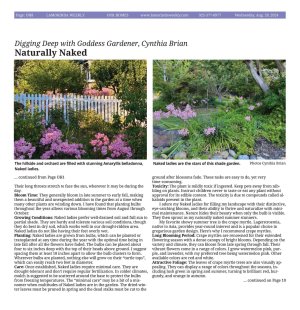|
|
Published August 28th, 2024
|
Digging Deep with Goddess Gardener, Cynthia Brian
|
| Naturally Naked |
| By Cynthia Brian |
 |
| Lighter pink Naked ladies shine at night. Photos Cynthia Brian |
"Nature loves to hide." Heraclitus
 In the winter, these ladies are wrapped in lush green manteaus that glisten in the rain. When warmer weather commences in late spring, their coats turn brown and eventually dry out. This is when we pull off their straps, leaving them lumpy and bumpy, hiding in plain sight. Sitting silently, they endure all measure of inconspicuousness. Then a sudden surprise transpires as they push their long slender necks skyward, shimmering in the summer sun.
In the winter, these ladies are wrapped in lush green manteaus that glisten in the rain. When warmer weather commences in late spring, their coats turn brown and eventually dry out. This is when we pull off their straps, leaving them lumpy and bumpy, hiding in plain sight. Sitting silently, they endure all measure of inconspicuousness. Then a sudden surprise transpires as they push their long slender necks skyward, shimmering in the summer sun.
 Amaryllis belladonna-magic lily, resurrection lily, surprise lily-the stunning Naked ladies have arrived! Just as most perennials in the garden have taken their final bow, these breathtaking bulbs fill my orchard and garden with their picture-perfect pink flowers. What began with the gift of a single bulb many years ago, has metamorphosed into a fabulous field of dreams because every season I dig up a few bulbs to plant in other areas.
Amaryllis belladonna-magic lily, resurrection lily, surprise lily-the stunning Naked ladies have arrived! Just as most perennials in the garden have taken their final bow, these breathtaking bulbs fill my orchard and garden with their picture-perfect pink flowers. What began with the gift of a single bulb many years ago, has metamorphosed into a fabulous field of dreams because every season I dig up a few bulbs to plant in other areas.
 Amaryllis belladonna is the botanical name of the flower, "Naked lady". Belladonna means "beautiful lady" in Italian. These plants are called Naked Ladies because of their unique bloom pattern. In the winter, the bulbs produce a bounty of beautiful, shiny green leaves like the leaves of agapanthus. Those leaves wither and die in spring around the same time that the strappy leaves of daffodils are browning. With so many bulbs, it takes me awhile to remove and compost the dead leaves. With the leaves gone, dirt-colored bulbs resemble rough turtle shells as their rounded heads form clusters. In August, single stems sprout from the ground. Finally, flowers emerge at the top of the stems giving them a striking appearance as if they're "naked" because they are standing alone without leaves.
Amaryllis belladonna is the botanical name of the flower, "Naked lady". Belladonna means "beautiful lady" in Italian. These plants are called Naked Ladies because of their unique bloom pattern. In the winter, the bulbs produce a bounty of beautiful, shiny green leaves like the leaves of agapanthus. Those leaves wither and die in spring around the same time that the strappy leaves of daffodils are browning. With so many bulbs, it takes me awhile to remove and compost the dead leaves. With the leaves gone, dirt-colored bulbs resemble rough turtle shells as their rounded heads form clusters. In August, single stems sprout from the ground. Finally, flowers emerge at the top of the stems giving them a striking appearance as if they're "naked" because they are standing alone without leaves.
 Here are some key things to know about Naked ladies:
Here are some key things to know about Naked ladies:
 Appearance: Naked ladies produce tall, elegant stems that can reach up to two feet in height, bearing masses of trumpet-shaped flowers that are usually pink, but can also be white or red. My Naked ladies showcase either a deep pink or blush color. Their long throats stretch to face the sun, wherever it may be during the day.
Appearance: Naked ladies produce tall, elegant stems that can reach up to two feet in height, bearing masses of trumpet-shaped flowers that are usually pink, but can also be white or red. My Naked ladies showcase either a deep pink or blush color. Their long throats stretch to face the sun, wherever it may be during the day.
 Bloom Time: They generally bloom in late summer to early fall, making them a beautiful and unexpected addition to the garden at a time when many other plants are winding down. I have found that planting bulbs throughout the year allows various blooming times from August through October.
Bloom Time: They generally bloom in late summer to early fall, making them a beautiful and unexpected addition to the garden at a time when many other plants are winding down. I have found that planting bulbs throughout the year allows various blooming times from August through October.
 Growing Conditions: Naked ladies prefer well-drained soil and full sun to partial shade. They are hardy and tolerate various soil conditions, though they do best in dry soil, which works well in our drought-ridden area. Naked ladies do not like having their feet overly wet.
Growing Conditions: Naked ladies prefer well-drained soil and full sun to partial shade. They are hardy and tolerate various soil conditions, though they do best in dry soil, which works well in our drought-ridden area. Naked ladies do not like having their feet overly wet.
 Planting: Naked ladies are grown from bulbs, which can be planted or transplanted at any time during the year with the optimal time being in late fall after all the flowers have faded. The bulbs can be placed about four to six inches deep with the top of their heads above ground. I suggest spacing them at least 18 inches apart to allow the bulb clusters to form. Wherever bulbs are planted, nothing else will grow on their "turtle tops", which can easily reach two feet in diameter.
Planting: Naked ladies are grown from bulbs, which can be planted or transplanted at any time during the year with the optimal time being in late fall after all the flowers have faded. The bulbs can be placed about four to six inches deep with the top of their heads above ground. I suggest spacing them at least 18 inches apart to allow the bulb clusters to form. Wherever bulbs are planted, nothing else will grow on their "turtle tops", which can easily reach two feet in diameter.
 Care: Once established, Naked ladies require minimal care. They are drought-tolerant and don't require regular fertilization. In colder climates, mulch is suggested to be scattered around the base to protect the bulbs from freezing temperatures. The "minimal care" may be a bit of a misnomer when multitudes of Naked ladies are in the garden. The dried winter leaves must be pruned in spring and the dead stalks must be cut to the ground after blossoms fade. These tasks are easy to do, yet very time-consuming.
Care: Once established, Naked ladies require minimal care. They are drought-tolerant and don't require regular fertilization. In colder climates, mulch is suggested to be scattered around the base to protect the bulbs from freezing temperatures. The "minimal care" may be a bit of a misnomer when multitudes of Naked ladies are in the garden. The dried winter leaves must be pruned in spring and the dead stalks must be cut to the ground after blossoms fade. These tasks are easy to do, yet very time-consuming.
 Toxicity: The plant is mildly toxic if ingested. Keep pets away from nibbling on plants. Instruct children never to taste or eat any plant without approval for its edible content. The toxicity is due to compounds called alkaloids present in the plant.
Toxicity: The plant is mildly toxic if ingested. Keep pets away from nibbling on plants. Instruct children never to taste or eat any plant without approval for its edible content. The toxicity is due to compounds called alkaloids present in the plant.
 I adore my Naked ladies for filling my landscape with their distinctive, eye-catching blooms, and their ability to thrive and naturalize with minimal maintenance. Nature hides their beauty when only the bulb is visible. They then sprout as my naturally naked summer stunners.
I adore my Naked ladies for filling my landscape with their distinctive, eye-catching blooms, and their ability to thrive and naturalize with minimal maintenance. Nature hides their beauty when only the bulb is visible. They then sprout as my naturally naked summer stunners.
 My favorite showy summer tree is the crape myrtle. Lagerstroemia, native to Asia, provides year-round interest and is a popular choice in gregarious garden design. Here's why I recommend crape myrtles.
My favorite showy summer tree is the crape myrtle. Lagerstroemia, native to Asia, provides year-round interest and is a popular choice in gregarious garden design. Here's why I recommend crape myrtles.
 Long Blooming Period: Crape myrtles are renowned for their extended flowering season with a dense canopy of bright blooms. Depending on the variety and climate, they can bloom from late spring through fall. Their vibrant flowers come in a range of colors. I grow watermelon pink, purple, and lavender, with my preferred tree being watermelon pink. Other available colors are red and white.
Long Blooming Period: Crape myrtles are renowned for their extended flowering season with a dense canopy of bright blooms. Depending on the variety and climate, they can bloom from late spring through fall. Their vibrant flowers come in a range of colors. I grow watermelon pink, purple, and lavender, with my preferred tree being watermelon pink. Other available colors are red and white.
 Attractive Foliage: The leaves of crape myrtle trees are also visually appealing. They can display a range of colors throughout the seasons, including lush green in spring and summer, turning to brilliant red, burgundy, and orange in autumn. Variety of Sizes and Forms: Crape myrtles come in various sizes and forms, from small shrubs to large trees. On one hillside, I grow purple shrubs which I shape to size. I also have multi-trunk specimens. The versatility of crape myrtle plants allows them to fit into various garden styles and spaces, from small urban gardens to expansive landscapes like mine.
Attractive Foliage: The leaves of crape myrtle trees are also visually appealing. They can display a range of colors throughout the seasons, including lush green in spring and summer, turning to brilliant red, burgundy, and orange in autumn. Variety of Sizes and Forms: Crape myrtles come in various sizes and forms, from small shrubs to large trees. On one hillside, I grow purple shrubs which I shape to size. I also have multi-trunk specimens. The versatility of crape myrtle plants allows them to fit into various garden styles and spaces, from small urban gardens to expansive landscapes like mine.
 Attractive Bark: One of the distinctive features of crape myrtles is their exfoliating bark. The peeling bark reveals shades of brown, gray, and cream, adding a textural and visual element to the tree's appearance in winter.
Attractive Bark: One of the distinctive features of crape myrtles is their exfoliating bark. The peeling bark reveals shades of brown, gray, and cream, adding a textural and visual element to the tree's appearance in winter.
 Low Maintenance: Once established, crape myrtles are relatively low maintenance. They are drought-tolerant and can thrive in a variety of soil types. They also resist many common pests and diseases, making them a practical choice for many gardeners. They can be pruned after blooming to reduce size, or allowed to flourish naturally for a fuller, taller tree.
Low Maintenance: Once established, crape myrtles are relatively low maintenance. They are drought-tolerant and can thrive in a variety of soil types. They also resist many common pests and diseases, making them a practical choice for many gardeners. They can be pruned after blooming to reduce size, or allowed to flourish naturally for a fuller, taller tree.
 Versatility: They can be used in various landscape applications, including as standalone specimens, in hedgerows, or as part of mixed borders. Their adaptability to different growing conditions and their ability to be pruned into various shapes make them versatile garden plants.
Versatility: They can be used in various landscape applications, including as standalone specimens, in hedgerows, or as part of mixed borders. Their adaptability to different growing conditions and their ability to be pruned into various shapes make them versatile garden plants.
 Because of the combination of a long flowering period, beautiful foliage, gorgeous naked bark, and adaptable nature, the crape myrtle is my beloved tree.
Because of the combination of a long flowering period, beautiful foliage, gorgeous naked bark, and adaptable nature, the crape myrtle is my beloved tree.
 Nature may like to hide but with the naturally naked Amaryllis belladonnas and Lagerstroemias in full bloom in my garden, the curtain has been pulled wide open and the spectacle is a showstopper.
Nature may like to hide but with the naturally naked Amaryllis belladonnas and Lagerstroemias in full bloom in my garden, the curtain has been pulled wide open and the spectacle is a showstopper.
 Happy gardening. Happy growing.
Happy gardening. Happy growing. |
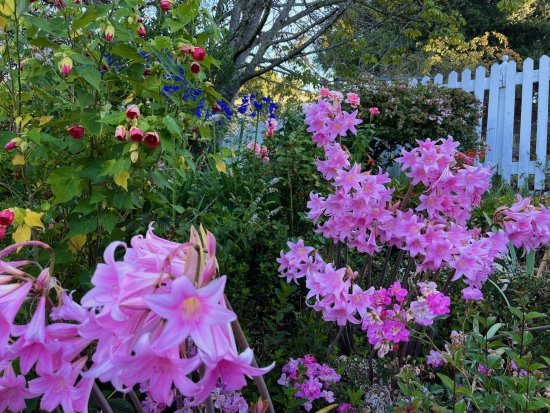 |
| With blue agapanthus and red-veined Chinese lantern as a background, Naked ladies are magical. Photos Cynthia Brian |
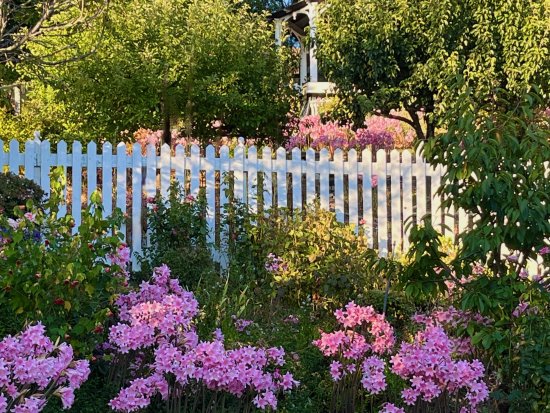 |
| The hillside and orchard are filled with stunning Amaryllis belladonna, Naked ladies. Photos Cynthia Brian |
 |
| Naked ladies are the stars of this shade garden. Photos Cynthia Brian |
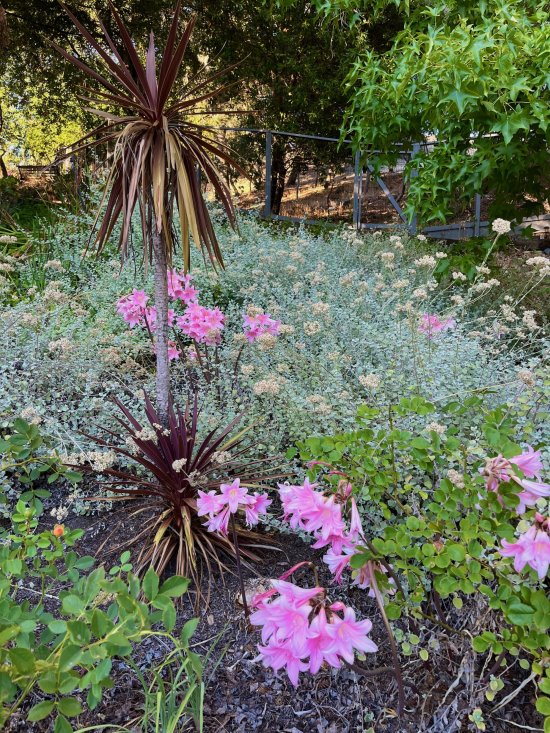 |
| Bright pink surprise lilies balance the gray licorice plant and burgundy cordyline. Photos Cynthia Brian |
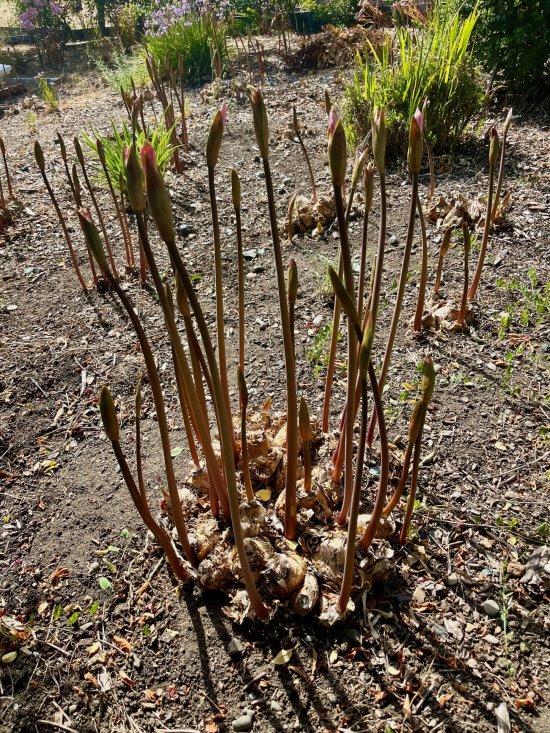 |
| The naked legs grow above the "turtle tops" of the resurrection
lilies. |
 |
Cynthia Brian amongst white agapanthus with Naked ladies starting to shoot.
For more gardening advice for all seasons, check out Growing with the Goddess Gardener at
https://www.CynthiaBrian.com/books. Raised in the vineyards of Napa County, Cynthia Brian is a New York Times best-selling author, actor, radio personality, speaker, media and writing coach as well as the Founder and Executive Director of Be the Star You Are!r 501 c3 which was just honored as the 2024 Nonprofit of the Year by the Moraga Chamber of Commerce. Tune into Cynthia's StarStyler Radio Broadcast at
www.StarStyleRadio.com. Her newest children's picture book, Books in the Barnyard: Oh Deer!, from the series, Stella Bella's Barnyard Adventures is available at
https://www.CynthiaBrian.com/online-store. Hire Cynthia for writing projects, garden consults, and inspirational lectures.
Cynthia@GoddessGardener.com
https://www.CynthiaBrian.com |
|
|
|









